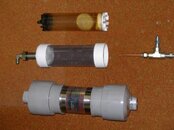realdiver7
Contributor
Hoosier....thanks for the first-hand info. I understand adding extra filtration can cost quite a bit and be somewhat involved when trying to keep a system as small as possible. My filling operation is very small-scale and for personal use only, so I don't fill that many tanks. I'll make sure to keep a close eye on moisture issues, especially when I VIP my steel tanks. I have a large thermometer with a relative humidity gauge in my garage and I pump fresh air from outside of the garage, so I know about how high the humidity is every time I pump air. I am prepared to change filter media hopefully not less than every 15 hours, but will change more often if needed, i.e., every 15-20 fills.
You seem to be on the right track with your summations as an Alkin dealer told me that adding larger filtration accomplishes much more than keeping the stock filtration canister pressurized.
If you ever run across a good extra filtration deal, please let me know. I'm willing to make reasonable improvements to my system whenever possible.
Thanks!
You seem to be on the right track with your summations as an Alkin dealer told me that adding larger filtration accomplishes much more than keeping the stock filtration canister pressurized.
If you ever run across a good extra filtration deal, please let me know. I'm willing to make reasonable improvements to my system whenever possible.
Thanks!




